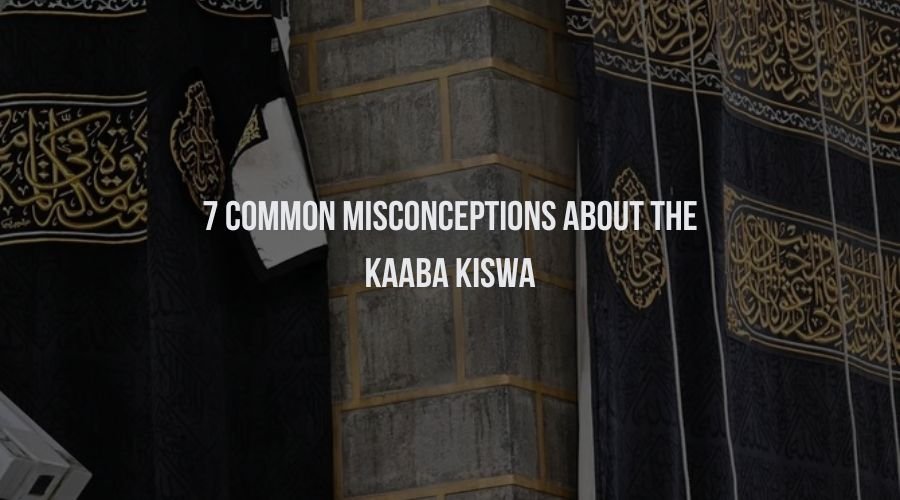Introduction
The Kaaba, a cubical structure in Mecca, stands as the holiest site in Islam. Draped in a magnificent cloth known as the Kiswah, it attracts the gaze and prayers of millions every year. As a leading provider of beautiful Islamic home decor inspired by the rich heritage of Islam, Kiswah Islamic Store is dedicated to fostering a deeper understanding and appreciation of Islamic traditions. But along with the Kaaba Kiswah’s fame come a few misconceptions about this revered covering. Let’s shed light on some of the most common ones!
Misconception #1
The Kiswa is the Original Covering of the Kaaba
While the Kiswah is a deeply symbolic element, it’s not the very first covering the Kaaba received. Historical accounts suggest the Kaaba was adorned with various coverings throughout history, including a simple cloth offered by the Yemeni tribe of Jurhum and a tapestry gifted by the Kindah tribe. The tradition of a more elaborate Kaaba Kiswa is believed to have been established much later, possibly during the time of the Quraysh tribe, who ruled Mecca before Islam.
Misconception #2
The Kiswa is Made of Pure Silk
While silk does play a role, the Kaaba cover isn’t entirely made of it. Traditionally, it was woven from pure black silk. However, after numerous renovations and restorations, the modern Kiswah incorporates a blend of high-quality silk and Kiswah fabric, a special type of synthetic material designed for durability in the harsh desert climate. This blend ensures the Kiswah’s beautiful appearance and longevity while withstanding the elements and the touch of millions of pilgrims.
Misconception #3
The Kiswa Never Changes
The Kaaba Kiswa undergoes a yearly replacement ceremony, a tradition dating back centuries. A new Kiswa is meticulously crafted in a special factory located within the Masjid al-Haram complex. The old Kaaba Kiswa is cut into small pieces, which are often distributed as sacred keepsakes to dignitaries and mosques around the world. This practice reflects the respect and reverence held for the cloth that once adorned the Kaaba.
Misconception #4
The Embroidery on the Kiswa Represents Idolatry
The elegant calligraphy embroidered onto the Kiswah cover features verses from the Quran, the Islamic holy book. These verses glorify God (Allah) and serve as a reminder of the Kaaba’s purpose as a place of worship for one God. The embroidery doesn’ t represent any idols or deities; it’s a form of Islamic art that reinforces the message of monotheism.
Misconception #5
Anyone Can Touch the Kiswa
Due to the immense respect accorded to the Kiswa and the potential for damage from the sheer number of pilgrims, directly touching the cloth is discouraged. However, pilgrims can perform the act of “tawaf,” circumambulating the Kaaba while keeping a respectful distance from the Kiswa. This act allows them to connect with the holiest site in Islam without compromising the integrity of the covering.
Misconception #6
The Kiswa Grants Blessings if Touched or Possessed
While the Kaaba Kiswa is a revered symbol, some believe possessing a piece brings blessings. It’s important to remember that blessings come from Allah (SWT), not from physical objects. The true significance lies in the spiritual connection one feels while performing Hajj or seeing the Kaaba cover.
Misconception #7
The Kiswa Threads are Used for Magic
Sadly, there are misconceptions about the Kiswa’s threads being used for magical purposes. This is not only disrespectful to the sanctity of the Kaaba cover but also holds no basis in Islamic teachings.
Misconception #8
The Kiswa Fabric is Woven with Gold Threads
The Kaaba cover is traditionally woven from pure black silk, with a band of gold-embroidered Quranic inscriptions running horizontally around the cloth. While some might mistake the intricate embroidery for gold threads, the base fabric itself remains pure silk.
Misconception #9
The Kiswa is Made Outside Saudi Arabia
Since the late 19th century, the honor of preparing the Kiswa has been bestowed upon the Kiswa Factory located within the precincts of the Grand Mosque in Mecca. Skilled Saudi artisans meticulously weave and embroider the cloth, ensuring its authenticity and adherence to religious requirements.
The True Significance of the Kiswa
The Kaaba Kiswa serves as a powerful symbol of unity and equality in Islam. People from all walks of life, ethnicities, and backgrounds come together in reverence before the Kaaba, united under the same magnificent cloth. The Kaaba Kiswa also represents the importance of honoring traditions while maintaining a sense of renewal, as it’s replaced annually.
Appreciating the Kiswa with Respect
By understanding the true meaning and purpose of the Kiswa, we can appreciate its significance and avoid perpetuating misconceptions. During Hajj, pilgrims can focus on the spiritual journey and the act of Tawaaf, respecting the boundaries set in place to protect the sacred cloth.
So, the next time you see an image of the Kaaba adorned in its magnificent Kiswa, remember the rich history, symbolism, and dedication that goes into its creation. It’s a powerful reminder of the unifying spirit of Islam and the importance of respecting traditions while maintaining a spirit of renewal.




